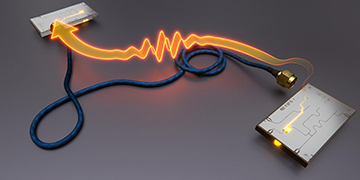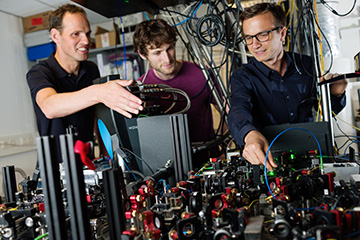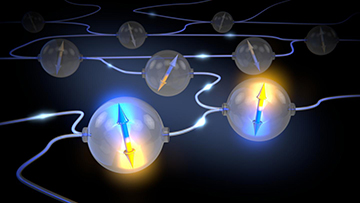
In one of two recent demonstrations of entanglement-on-demand, a team at ETH Zürich transferred the quantum state of one superconducting qubit to another qubit via a 0.9-m length of coaxial cable. [Image: ETH Zurich /M. Pechal, T. Walter, P. Kurpiers]
In the past decade, researchers have made giant strides in demonstrating entanglement—the nonclassical correlation between sometimes distantly separated systems of photons or particles that constitutes a key aspect of “quantum weirdness.” But creating a true network of entangled nodes, of the sort that would underpin a future quantum internet, presents a much higher hurdle to clear. That’s because such a network would demand a level of fidelity and predictability in the creation and transfer of entangled states that most demos haven’t yet approached.
In two separate studies, research groups in Europe now report that they have found potentially practical ways to transfer entangled quantum states from point A to point B deterministically—at the push of the proverbial button. While much still needs to be done, the demonstrations appear to have nudged the state of the quantum art closer to the goal of scalable quantum networks.
From probability to certainty
Much of the entanglement news in recent years has related to demonstrations of large numbers of entangled particles in a single system, or the transfer of an entangled state across increasing distances (stretching, in a 2017 spaceborne example, to some 1200 km). From the point of view of building a true quantum network with multiple entangled nodes, however, these examples have a problem: They tend to be built on “probabilistic” platforms. That means, in essence, that the generation and transfer of a entangled quantum state has some (possibly small) finite likelihood, to be realized through a (possibly very large) number of repeated efforts.
A network of multiple nodes, by contrast, requires a more reliable, deterministic scheme—one that can create and transfer quantum states essentially on demand. Without such a deterministic scheme, the probability of transferring the entangled state would degrade with each jump to a new network node. That would scotch the use of entanglement to underpin visions such as distributed quantum computing, in which computation takes place in a series of separate but entangled quantum registers. It also forecloses certain entanglement-based schemes for secure quantum communications, which require the repeated transfer of entangled states from one short segment to another in a long-haul network.
Toward a deterministic approach
Research groups in Switzerland, led by Andreas Wallraff of ETH Zürich, and in the Netherlands and United Kingdom, led by Ronald Hanson of the Delft University of Technology’s quantum research facility QuTech, have now put on the table two different techniques for deterministically delivering entangled states to a remote network node.
The ETH Zürich method (Nature, doi: 10.1038/s41586-018-0195-y) taps into an idea first floated theoretically more than 20 years ago (Phys. Rev. Lett., doi: 10.1103/PhysRevLett.78.3221). That concept involved using laser pulses to excite an atom within a single-mode optical cavity, mapping the atom’s quantum state into a time-symmetric photon that is then sent through a transmission line to a receiving node and absorbed by a receiving atom. The approach, according to the original paper, should be able to transfer entanglement from the first atom to the second “with unit probability.”
Cavities and coax cable
To put that scheme into operation, Wallraff’s team at ETH set up a system of two superconducting, cryogenically cooled quantum bits, or qubits, coupled to two separate microwave-frequency resonators and connected together with just under a meter of coaxial cable. Applying coherent microwave pulses to the first qubit drives the creation of photons that are sent through the cable and captured by the second qubit, which thereby inherits the first qubit’s quantum state. The result: entanglement between the two nodes.
The team found that it could distribute a new entangled state every 0.2 milliseconds, with a transfer probability of more than 98 percent and a fidelity (a measure of how accurately the entangled state is being transferred) on the order of 80 percent. The researchers believe that the fidelity could be pushed up to as high as 93 percent with further development of the technique—making it, in the words of the authors, a possible basis “for distributed quantum computation in the circuit quantum electrodynamic architecture using distinct cryogenic nodes.”
Faster creation, slower destruction

Paper coauthors Ronald Hanson, Peter Humphreys and Norbert Kalb, of QuTech and Delft University of Technology. [Image: TU Delft/Marieke de Lorijn]
The Hanson-led group at Delft, meanwhile, approached the problem of deterministic entanglement transfer from another angle: putting an existing, non-deterministic scheme into overdrive, to make it deterministic (Nature, doi: 10.1038/s41586-018-0200-5).
The Delft researchers reasoned that, if an intrinsically probabilistic entangling protocol can create entanglement between nodes at a rate greater than the rate at which entanglement is destroyed or lost through decoherence, then it can be used to provide on-demand entanglement transfer at specific times—even though the protocol itself isn’t deterministic. In other words, if enough entanglement attempts can be created and kept alive in the time slice of interest, an entangled state can be delivered with virtual certainty in that time slice.
NV spin centers
To put the idea to the test, the Delft group used a platform consisting of two qubits in diamond nitrogen-vacancy (NV) centers. NV centers are a common platform for quantum-computing experiments, in which the quantum spin states in defects within the diamond crystal lattice act as the carriers of quantum information. The researchers separated the two qubit nodes by around two meters, tying them with optical fiber to a beamsplitter and single-photon detectors.

Artist’s impression of a quantum network based on qubits in diamond nitrogen vacancy (NV) centers, analogous to Delft entanglement experiment. [Image: Scixel/TU Delft]
The two nodes were then prepared with identical NV spin states, and the researchers used laser pulses to entangle the state in each NV center with an optical photon that was sent down the fiber. The detection of a only single photon at a point midway between the two systems heralds entanglement between the spin states two NV nodes.
While the platform for the recent experiments was not new, the Delft team was able to improve it to produce heralded entanglement at rates of 40 times per second, three orders of magnitude higher than previous efforts. The group also developed ways to protect the entangled states by shielding the NV centers from external noise sources and through a new scheme of “dynamical decoupling” from remaining quasi-static noise. As a result, the rate of entanglement creation outstripped the rate of loss, and the team was able to deliver entangled states deterministically, at a 10-Hz rate (one entangled state every 100 ms).
Steps toward a quantum internet?
The Delft experiment, like the ETH Zürich one, demonstrated entanglement between only two network nodes. However, in principle, at least, the ability to keep the entangled state alive for a longer period also buys time to transfer the entanglement to a third network node. “The challenge,” Hanson said in a press release accompanying the work, “is now to be the first to create a network of multiple entangled nodes—the first version of a quantum internet.” Hanson hopes to be able to create such a quantum-entangled network between four cities in the Netherlands by 2020.
